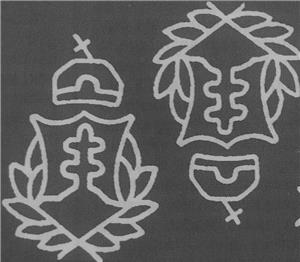Stamp: Virgin Mary, Patroness of Hungary (Hungary 1943)
Virgin Mary, Patroness of Hungary (Hungary 1943)
01 January (Hungary ) within release Characters and Relics of Hungarian History goes into circulation Stamp Virgin Mary, Patroness of Hungary face value 18 Hungarian fillér
| Stamp Virgin Mary, Patroness of Hungary in catalogues | |
|---|---|
| Philatelia Hungarica Catalog: | PHu: HU 752V/A2 |
Stamp is vertical format.
Also in the issue Characters and Relics of Hungarian History:
- Stamp - Artúr Görgey (1818-1916) Honvéd general face value 12;
- Stamp - Artúr Görgey (1818-1916) Honvéd general face value 12;
- Stamp - Count András Hadik (1710-1790) field marshal face value 10;
- Stamp - Count András Hadik (1710-1790) field marshal face value 10;
- Stamp - Count Miklós Zrínyi (1508-1566) face value 6;
- Stamp - Count Miklós Zrínyi (1508-1566) face value 6;
- Stamp - Crown of St. Stephen face value 1;
- Stamp - Crown of St. Stephen face value 1;
- Stamp - Crown of St. Stephen face value 20;
- Stamp - Crown of St. Stephen face value 20;
- Stamp - Ferenc II Rákóczi (1676-1735) face value 8;
- Stamp - Ferenc II Rákóczi (1676-1735) face value 8;
- Stamp - János Hunyadi (1385-1456) face value 4;
- Stamp - János Hunyadi (1385-1456) face value 4;
- Stamp - Miklós Toldi, 14th Century Hero face value 3;
- Stamp - Miklós Toldi, 14th Century Hero face value 3;
- Stamp - Pál Kinizsi (-1494) face value 5;
- Stamp - Pál Kinizsi (-1494) face value 5;
- Stamp - Ruling Prince Árpád (c. 850-907) face value 1;
- Stamp - Ruling Prince Árpád (c. 850-907) face value 1;
- Stamp - Saint László I (1040-1095) King of Hungary face value 2;
- Stamp - Saint László I (1040-1095) King of Hungary face value 2;
- Stamp - Virgin Mary, Patroness of Hungary face value 18;
- Stamp - Virgin Mary, Patroness of Hungary face value 18;
- Stamp - Virgin Mary, Patroness of Hungary face value 24;
- Stamp - Virgin Mary, Patroness of Hungary face value 24;
Stamp Virgin Mary, Patroness of Hungary it reflects the thematic directions:
A coat of arms is an heraldic visual design on an escutcheon (i.e. shield), surcoat, or tabard. The coat of arms on an escutcheon forms the central element of the full heraldic achievement which in its whole consists of shield, supporters, crest, and motto. A coat of arms is traditionally unique to an individual person, family (except in the United Kingdom), state, organisation or corporation.
Myth is a genre of folklore consisting primarily of narratives that play a fundamental role in a society. For scholars, this is very different from the vernacular usage of the term "myth" that refers to a belief that is not true. Instead, the veracity of a myth is not a defining criterion
Religion is any cultural system of designated behaviors and practices, world views, texts, sanctified places, ethics, or organizations, that relate humanity to the supernatural or transcendental. Religions relate humanity to what anthropologist Clifford Geertz has referred to as a cosmic "order of existence". Different religions may or may not contain various elements ranging from the "divine", "sacred things", "faith", a "supernatural being or supernatural beings" or "some sort of ultimacy and transcendence that will provide norms and power for the rest of life". Religious practices may include rituals, sermons, commemoration or veneration (of deities), sacrifices, festivals, feasts, trances, initiations, funerary services, matrimonial services, meditation, prayer, music, art, dance, public service, or other aspects of human culture. Religions have sacred histories and narratives, which may be preserved in sacred scriptures, and symbols and holy places, that aim mostly to give a meaning to life. Religions may contain symbolic stories, which are sometimes said by followers to be true, that have the side purpose of explaining the origin of life, the Universe and other things. Traditionally, faith, in addition to reason, has been considered a source of religious beliefs. There are an estimated 10,000 distinct religions worldwide. About 84% of the world's population is affiliated with one of the five largest religions, namely Christianity, Islam, Hinduism, Buddhism or forms of folk religion.



